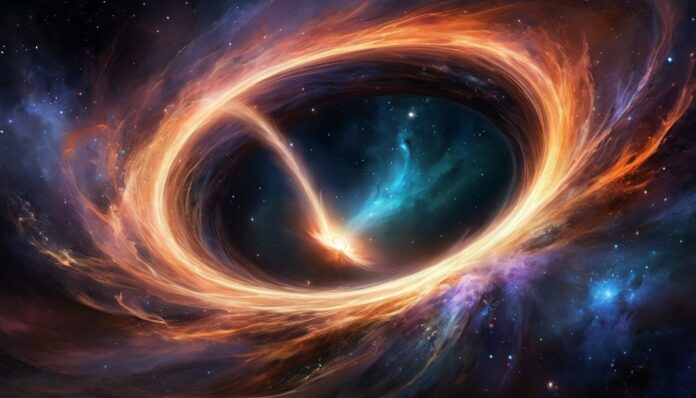A black hole is a region of space where gravity is so strong that nothing, not even light, can escape from it. Here are some key points about black holes:
Formation
- Stellar Collapse: Most black holes form when massive stars run out of nuclear fuel and collapse under their own gravity. If the core’s mass is sufficient, it collapses into a singularity—a point of infinite density with zero volume.
- Supermassive Black Holes: These are found at the centers of most galaxies, including the Milky Way, and their origins are not fully understood. They may form from the merging of smaller black holes or from large gas clouds collapsing directly into black holes.
Characteristics
- Event Horizon: This is the boundary around a black hole beyond which nothing can escape. It is the “point of no return.”
- Singularity: At the very center of a black hole lies the singularity, where density becomes infinite and the laws of physics as we know them break down.
- Accretion Disk: Material falling into a black hole often forms a disk around it, called an accretion disk. This material heats up and emits radiation, making the black hole indirectly observable.
Types of Black Holes
- Stellar Black Holes: Formed from the collapse of individual stars, typically with masses between a few times and a few dozen times that of our Sun.
- Intermediate Black Holes: These have masses ranging from hundreds to thousands of solar masses. Their existence is inferred but not well understood.
- Supermassive Black Holes: These have masses ranging from millions to billions of solar masses and are found at the centers of galaxies.
- Primordial Black Holes: Hypothetical black holes that could have formed in the early universe, with a wide range of possible masses.
Effects and Phenomena
- Gravitational Lensing: Black holes can bend light from objects behind them, creating a lensing effect that can magnify and distort the appearance of those objects.
- Time Dilation: According to general relativity, time moves slower near a black hole due to its intense gravitational field.
- Hawking Radiation: Theoretical prediction by physicist Stephen Hawking that black holes can emit radiation due to quantum effects near the event horizon, leading them to slowly lose mass and eventually evaporate over extremely long timescales.
Observation and Research
- Direct Imaging: The Event Horizon Telescope captured the first direct image of a black hole’s event horizon in the galaxy M87 in 2019.
- Gravitational Waves: The detection of gravitational waves by observatories like LIGO has provided evidence of black hole mergers, offering new insights into their properties and formation.
- X-ray Observations: Black holes are often detected by the X-rays emitted from the accretion disks of infalling material.
Black holes remain one of the most intriguing and mysterious objects in the universe, challenging our understanding of physics and the nature of reality.
Here are the most interesting facts about black holes.
- All stars in our galaxy orbit around the supermassive black hole located at its center.
- A black hole has such powerful gravity that it “sucks in” even light.
- In spring 2019, American scientists, for the first time in history, captured an “image” of a supermassive black hole located 54 million light-years from Earth.
- If our planet turned into a black hole, it would be the size of a table tennis ball.
- Astronomers claim that black holes evaporate over time.
- One black hole, located 35,000 light-years from Earth, rotates around its axis at a speed of almost 1000 revolutions per second!
- It’s interesting that black holes emit certain sounds, which is confirmed by corresponding sound recordings.
- A black hole poses no danger if one does not approach it too closely.
- A rotating black hole forms after the merger of 2 ordinary holes.
- Researchers of black holes still cannot answer the question of what remains after the completion of the hole’s quantum decay process.
- The boundary of the black hole region from which it is impossible to escape is called the event horizon.
- Currently, the largest black hole is located 228 light-years from our planet in the central part of the “NGC 1277” galaxy.
- At the end of its life, any star can turn into a black hole, provided its mass is at least 10 times that of the Sun.
- According to scientists, as one approaches the event horizon, time gradually slows down.
- The supermassive mass of a black hole distorts the space around it.
- After passing through the event horizon, not even light can escape from a black hole.
- Since a black hole absorbs light, it is impossible to see it.
- The nearest black hole is located approximately 20,000 light-years from our planet.
These astonishing phenomena challenge our understanding of the universe’s fundamental laws and inspire groundbreaking research in astrophysics. Black holes are not just objects of fascination; they are crucial for unraveling the mysteries of space-time and the evolution of galaxies.
